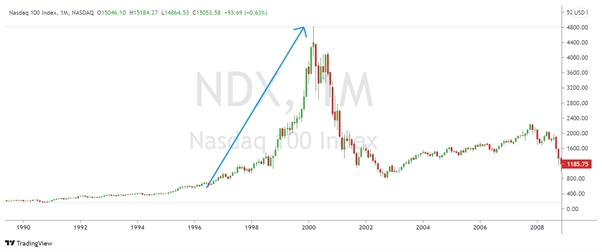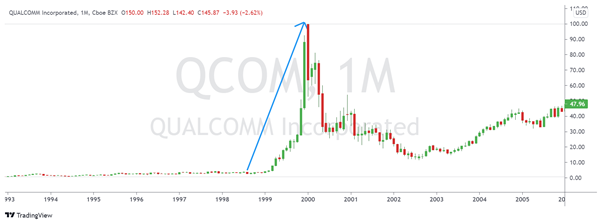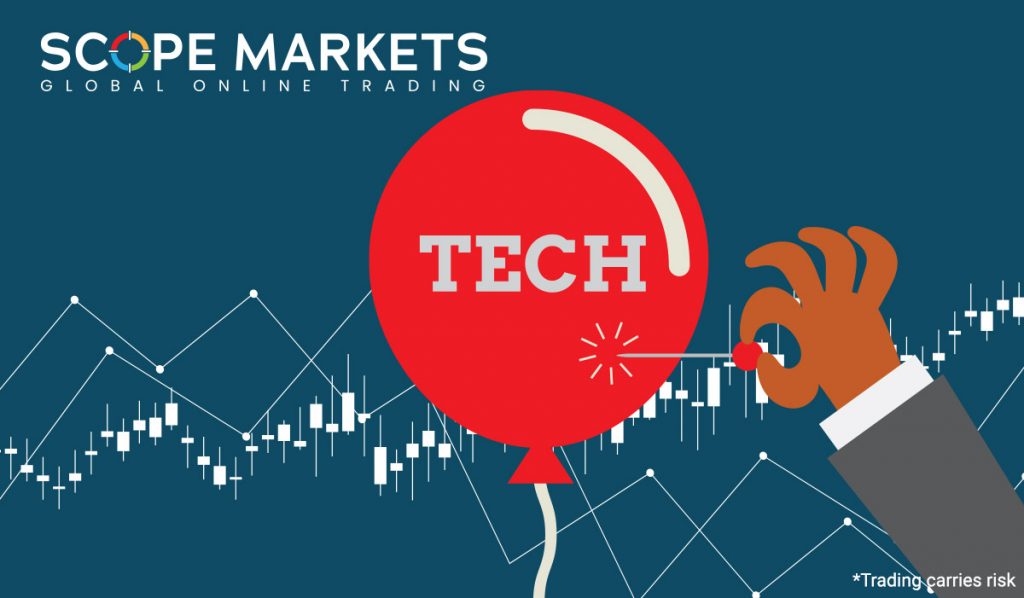Dot-com bubble and do we have another technology bubble

Table of Content
The dot-com bubble also called the dot-com inflation or boom, the technology, and the Internet bubble. It was a share market bubble created by the extreme reflection of Internet-linked organizations in the delayed 1990s. This was the time of huge growth in the usage and enactment of the Internet.
In 1995 and its top position in March 2000, the Nasdaq Composite index increased 400%. And, only to drop by 78% from its top position by October 2002, losing all its profits throughout the bubble.
NASDAQ

All through the crash, various online shopping firms, and many communication firms lost and got closed. Some organizations, such as whose shares dropped by 86%, Qualcomm, and Amazon dropped a huge part of their market cap but sustained.
QUALCOMM

Amazon

One of the most important questions for stockholders in 2021 is whether businesses are in a different technology bubble same as the dot-com bubble in 2000.
After 20 years of the dot-com bubble, is the technology bubble all set to burst once more?

The US technology big players have been on a breach for a year and have only grown in worth when Coronavirus knocked the US. In 2020, Bezos’s wealth secured at $184 billion, up by $69.3 billion from the beginning of the year. Also, with Tesla’s bigger losses, Musk’s wealth is up by $64 billion for the year, finishing at $91.5 billion.
If it is a technology bubble, it is then created of powerful stuff than the one that broke at the shift of the millennium. That bubble was outlined by growing startup firms like Pets.com, which ran out of market only 9 months later in its much-inclined stock trade. This one is getting expanded by a few of the largest, most valuable organizations the world has always seen.
What do analysts say about the tech bubble?

Alan Patrick, the co-founder of an analytics company, has observed his stock of technology bubbles. So, he observes a lot of fizz at the time, he does not still think that this is a bubble all set to burst. Even with tech share costs are so high, he stated, we may be at the highest of the bubble period.
The growth has much been from organizations that hold to profit very well from a realm that involves a phase change to a more digital and less tangible world. For example, Amazon, Zoom, MSFT Apple, Netflix all gain very much, since doing the Coronavirus drug and healthcare niche whose stocks have soared, he said.
One large variance between today’s technology giants and their dot-com ancestors is volume. These are large organizations that also generate excessive profits. In the earlier phase, Apple’s gross profit for the quarter finishing Dec. 31, 2020, was $44.328bn, a 25.87% growth YoY. Apple’s yearly gross profit for 2020 was $104.956bn, a 6.67% growth from 2019. Apple’s yearly gross profit for 2019 was $98.392bn, a 3.38% drop from 2018. Its yearly gross profit for 2018 was $101.839bn, a 15.48% growth from 2017. So, Apple got value over all the firms registered on the FTSE 100 of the United Kingdom’s largest firms mixed.
Is tech being secure heaven?

The business has grown for Amazon, Facebook, Apple, and Google still since the broader US market has fallen. Technology has been a secure haven, and a niche attaining growth when stockholders have tried to get growth or security elsewhere.
But only due to the condition being reversed this time, it does not signify that there is not a tech bubble to explode. All the components of a bubble condition stay in place, Chris Senyek the strategist at Wolfe Research drafted in an analysis note. Also, that bubble, he explained, was mostly raised in the Nasdaq 100 index, the tech stock index whose most important elements involve Amazon, Apple, Microsoft, Alphabet Inc., FB, Tesla, and Netflix.
Approx. 29mn individuals are now on lay-off benefits in the United States. Also, there are clues that the financial bounce-back from the lockdowns due to Coronavirus has been reduced. Furthermore, US share markets have stayed near to their exciting highs because the Federal Reserve has kept its power behind them, and had interest rates near to 0.
Though for Senyek and other people, the current wobbles can have difficulty ahead. This is very absurd to occur any time earlier. But, this bubble can yet stay relaxed by continued financial failures.
The current selloffs came next to technology shares that were then taken to new positions by verdicts of Tesla, Apple, and others to separate their shares, a shift that created them inexpensive to own. But, not done anything to alter the basics of their businesses. They were also driven higher by a big chance on technology by the conglomerate Soft Bank of Japan that was then attached to approx. $50bn value of specific tech shares.
Do actual problems yet to come?
Actual problems may come out only when the Coronavirus comes to an end. Tech flourished since the world went online, but would we always wish to grow again when it is over? Some basics have been replaced– bricks-and-mortar buying, much disturbed before Coronavirus, may not at all come to its previous levels. But technology’s present authority may also decline once the world completely opens.
Next, there are a few federal headwinds. So, if the government of Europe and the US have become much cautious about Big Technology’s supremacy, such problems would only have increased by the lockdowns. Also, post-Coronavirus, technology may finally confront the true political adversaries.
Are there any outstanding bubble signals?
Patrick said that he will wait to view more outstanding bubble signals previous to any actual blowout. Say, big numbers of customers getting involved in investing – and, that is beginning, with the latest financial dealing applications giving free stock trading and holding parts of shares in organizations.
Although he warned that in the present situation, anything was likely to occur. Various circumstances can direct to a share market bash, involving another wave of Coronavirus, the chance of more terrible financial news, or anything else.
Also, he doesn’t think that there has been a moment, since the conclusion of the Cold War, when there are various more possible and huge shocks that can prevent the growing bubble in its way and hit it.
Druckenmiller, in an interview, said that I have no hint where the market will go in the next term. Also, I do not know even if it is continuing to move up by 10%. As well as I don’t understand even if it is moving down by 10%, percent.
Comparing tech landscape to the dot com bubble era of 2000
The dot-com bubble and later crash are shown in the below image, as shown by Ofek and Richardson. It depicts the worth of the internet stocks grown their value with approx. 1000% in the time from Oct. 1998 until March 2000. Also, how the value reduced by the conclusion of 2000 to a worth approx. as reduced in Oct. 1998. The internet stocks are here shown by an index described by Morgan Stanley. The graph also depicts how the S&P 500 index and the NASDAQ indexes grown all through the same time. Note the S&P 500 index shows a broad range of segments in the US market, while the NASDAQ index is mainly for organizations categorized as technology firms. As well as the NASDAQ index is shown as a bubble, though not as dramatic as for the online companies, and the growth and drop of the NASDAQ was to a huge extent brought by the Internet firms.
It is sometimes classified as what is a bubble breaking and what is an improvement. Different finance articles recommend that an improvement must not go beyond a 20% value loss in the market. With this description in mind, bubbles breaking are somewhat normal- but, the dot-com bubble is still dramatic in its consequences.
The above figure depicts the P/E ratio of the S&P index from the 1880s to the year 2000. We identify the bubble of 1929 and the dot-com bubble. Also, we see that there were bubbles from 1901 and 1966. For the dot-com bubble, the P/E ratios reached higher than ever, up to 44.3 by Jan 2000. One more great view is that each time the P/E ratio has grown to points more than 20, the market has observed a big fixing or crash in the later periods. It also shows that a normal P/E ratio would be between 10 and 20.
The 12-month forward Price to Earnings ratio of the S&P 500 index was 20.4 on May 7. The final time the index beat 20 previous to this history week was on 10th April 2002.
This forward Price to earnings ratio of 20.4 hit the 5-year by 16.7, the 10-year by 15.1, the 15-year by 14.6, and the 20-year by 15.4 S&P 500 factual averages. The S&P 500 index is not away from its twenty-year growth of 23.4 as published on Sep. 1, 2000 (all through the dot-com bubble).
The forward Price to Earnings ratio was only 13.1 on 23rd when the share market hit the base.
Conclusion- Dot-com bubble to another technology bubble
Our study shows that as the present tech enterprises have still to engross the extreme estimates observed in the lead up to the dot-com bang, their estimates points get raised. In fact, in many subclasses, they are more than they were in almost all different years apart from the head-up to the technology bubble in 1998- 1999.
The valuation points would need to be doubling or even tripling to assess in March 2020. Also, analysts would no doubt proceed to venture and utter the caution. Technology is now magnified and reaching the dot-com bubble mandate, they would suggest.
So, when we talk about the stock market, there is one of the finest methods to defend your portfolio from a possible drop from a stock market bubble. That is by changing into diverse market segments and asset categories. Also, keeping a balanced level of money in your stock account to take benefit of any possible buying chances that may come out if the share market goes in the opposite direction.
References:
- https://blogs.cfainstitute.org/investor/2020/11/03/dot-com-redux-is-this-tech-bubble-different/
- https://www.marketwatch.com/story/what-burst-the-dot-com-bubble-and-will-it-happen-again-in-2021-2020-12-30
- https://www.theguardian.com/business/2020/sep/12/twenty-years-after-the-dotcom-crash-is-techs-bubble-about-to-burst-again
Disclaimer: This material is a marketing communication and shall not in any case be construed as an investment advice, investment recommendation or presentation of an investment strategy. The marketing communication is prepared without taking into consideration the individual investors personal circumstances, investment experience or current financial situation. Any information contained therein in regardsto past performance or future forecasts does not constitute a reliable indicator of future performance, as circumstances may change over time. Scope Markets shall not accept any responsibility for any losses of investors due to the use and the content of the abovementioned information. Please note that forex trading and trading in other leveraged products involves a significant level of risk and is not suitable for all investors.







